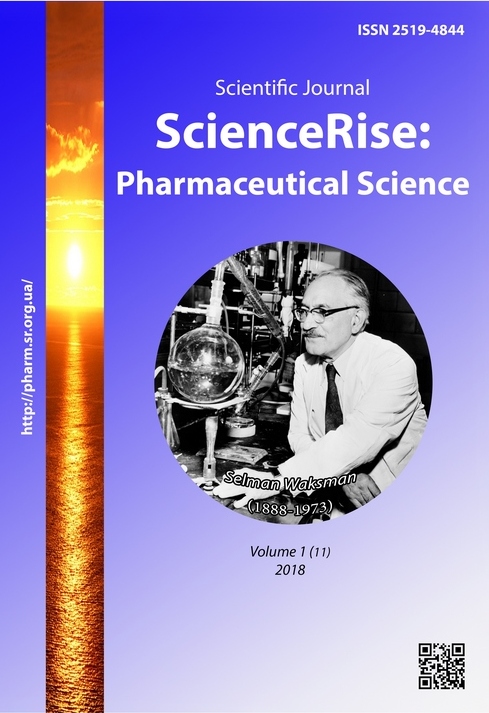In vitro susceptibility study of Candida Spp. isolates to new combined potential medicinal product for the treatment of vaginal candidiasis
DOI:
https://doi.org/10.15587/2519-4852.2018.124534Keywords:
suppositories, vaginal candidiasis, antimycotic activityAbstract
Research of the antimicrobial action of model specimens of a potential drug in various fixed combinations and the advent of specific antimycotic activity of model samples of a new, combined, potential drug and medicine product, selected as a reference "Neo-Penotran®" (Exeltis Healthcare S.L., Spain).
Aim of the research was to determine the susceptibility of in vitro Candida spp. isolates to a new combined drug containing a substance with an antimycotic activity for the treatment of vaginal candidiasis.
Materials and methods. Candida albicans (ATCC 10231) and Candida albicans (clinical isolate) from the material, urogenital pathways from women with a diagnosis of candidiasis were used to prove the activity and determine the sensitivity.
The study of antimicrobial activity was carried out using the serial dilutions method in trypticase-soybean broth, which allowed to ensure a uniform distribution of the drug in the nutrient medium in contact with pathogenic strains, and the subsequent transfer to Petri dishes on Sabouraud agar - the most accurate evaluation of the results.
Results of the study of the antimycotic activity of 7 model specimens showed antimycotic activity in only 3 model specimens in relation to both the reference strain Candida albicans ATCC 10231 and the clinical strain of Candida albicans.
Conclusions. The results of the studies indicate that there is a strong in vitro antimycotic effect of the new potential combined drug against pathogenic test strains: Candida albicans ATCC 10231, Candida albicans (clinical isolate), which is not inferior to the selected reference medicine. Minimum inhibitory concentration of the test drug in vitro was established for pathogenic test strains: Candida albicans ATCC 10231, Candida albicans (clinical isolate). The study of various combinations and concentrations of the combined drug made it possible to exclude the presence of negative interaction between components of the experimental specimen and to select the most promising and effective sample for further experimental studies of combinations of antimycotics for intravaginal use
References
- Prilepskaya, V. N. (1996). Genital candidiasis. Modern approaches to treatment. Obstetrics and gynecology, 6, 28–29.
- Kubas', V. G., Chayka, N. A. (2010). Candidiasis. Saint Petersburg: Sotis, 40.
- Pavlenko, E. Yu., Ziyadinov, M. S. (2011). The place of candidiasis in infectious pathology at the present stage. Crimean Journal of Experimental and Clinical Medicine, 2, 63–66.
- Farasat, A., Sadraeian, M., Mohkam, M., Akbari Rad, S. (2012) Identification of Candida albicans isolated from Recurrent Vulvovaginal Candidiasis (RVVC) patients by PCR-RFLP method and its drug sensitivity to Zataria multiflora extract. European Journal of Experimental Biology, 6 (1), 58–61.
- Sergeev, A. Yu., Sergeev, Yu. V. (2007). Candidiasis: Nature of infection, mechanisms of aggression and protection, laboratory diagnostics, clinic and treatment. Moscow: Triada-X, 472.
- Evans, E. (2009). Diagnostic laboratory techniques in vaginal candidosis. Journal of clinical microbiology, 47 (12), 3821–3825.
- LaFleur, M. D., Qi, Q., Lewis, K. (2009). Patients with Long-Term Oral Carriage Harbor High-Persister Mutants of Candida albicans. Antimicrobial Agents and Chemotherapy, 54 (1), 39–44. doi: 10.1128/aac.00860-09
- Mironov, A. N. (Ed.) (2012). A guide to preclinical drug research. Moscow: FGBU "NTSESMP", 944.
- Stefanov, A. V. (2002). Preclinical research of medicines. Kyiv: Avicenna, 320.
- Golovkin, V. A., Golovkin, A. V., Golovkin, V. V. (2002). Medicines for external therapy of inflammation of the urino-genital organs. Zaporozhye: ZMGU, 152.
Downloads
Published
How to Cite
Issue
Section
License
Copyright (c) 2018 Iryna Nizhenkovska, Liudmyla Zinchenko

This work is licensed under a Creative Commons Attribution 4.0 International License.
Our journal abides by the Creative Commons CC BY copyright rights and permissions for open access journals.








